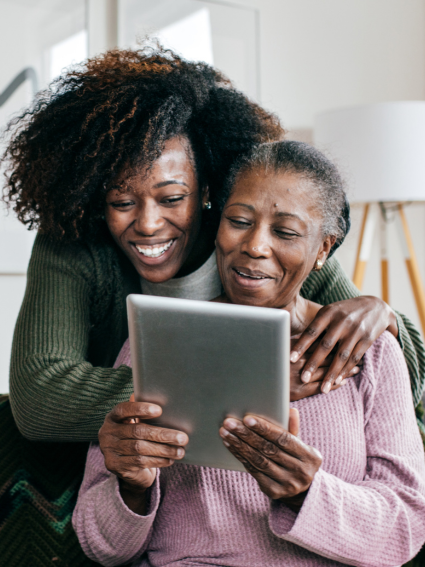March 1, 2024
technology and Aging
Tips and Trends

The demographic shift projected by the U.S. Census Bureau indicates a significant increase in the aging population, marking a historical first where older adults will outnumber children in the United States. These older adults express a strong inclination to age in place, fostering a desire to remain in their homes for as long as possible. Embracing technology becomes pivotal in realizing this goal.
The Role of Technology
Technology plays a critical role in facilitating effective communication and access to essential services for the aging community, particularly outside their homes. Telehealth platforms, delivery services for food, transportation options, social connectivity, entertainment avenues, and tools promoting independence form an essential part of this technological landscape. Moreover, assistive and health-related technologies within households serve to simplify and secure the lives of older Americans, fostering both independence and a heightened sense of safety and well-being.
The Aging Population’s Use of Technology + COVID-19
Recent trends show an increased acceptance of technology among older adults, especially over the past two decades. Service-oriented applications such as grocery and food delivery apps are gaining popularity, as are telehealth platforms that grant older adults a greater degree of independence. The adoption of assistive home technologies like voice-controlled thermostats and virtual assistant devices has also surged.
The COVID-19 pandemic drastically altered the aging population’s approach to technology. Seniors rapidly embraced online options, driven by the need to stay connected while minimizing exposure to the virus. This shift led to a significant surge in technology use among older adults. Presently, more than half of individuals aged 65+ own smartphones, and 75% of adults in the same age group utilize the internet. According to the Census Bureau, 53% of adults aged 55 and older use some form of assistive or health-related technology.
Barriers
Despite this surge in technology use among older adults, numerous barriers hinder their adoption of new technologies. Older adults emphasize the importance of ease of use, simple setup, mobile app accessibility, and wireless functionality when considering assistive or health-related technologies. Additionally, the rapid evolution of technology makes it challenging for members of the aging population to keep up. Ultimately, there remains a considerable learning curve for older adults navigating advanced devices and technology.
Digital Literacy Classes
In an effort to bridge the digital literacy gap and address existing barriers, Stefano Selorio established the innovative platform, Carevocacy in 2020. Stemming from his caregiving experience for his grandmother, who battles Alzheimer’s, Selorio envisioned a simpler way for seniors to learn technology. Recognizing the immense value of digital literacy for aging adults, his company aims to enhance the lives of seniors and their caregivers. In today’s interconnected world, technology intersects with crucial aspects of health, including food, education, social connections, and healthcare. The belief at Carevocacy is that it is never too late to learn! Based in Florida but operating nationally, they offer technology classes and private tutoring, prioritizing seniors’ social engagement, connectivity, and skill development. To learn more, visit their website https://carevocacy.com/ .
Carevocacy isn’t alone in this endeavor. Numerous initiatives strive to bridge this digital divide, demonstrating that it’s never too late for individuals to support their loved ones in navigating technology. The key lies in continuous learning and assistance.
Here are a couple of technological tools and devices that can help support your loved one in aging in place:
1. Automatic Lights: As we age our vision changes, and it can become harder to see clearly at night. Automatic lights in the bathroom and hallways can reduce the chance of your loved one stumbling in the dark. You might want to consider lights on a timer, motion sensor lights, or a voice-activated lighting system.
2. Emergency Response Systems: ERS have been around for years but have evolved to be quite advanced and even stylish. An ERS can provide fall detection, GPS tracking, and automatic emergency alerts. Depending on the system you may pre-program the system to call you, another family member, a neighbor, or emergency services in an emergency.
3. Smart Watches: These can be multi-purposeful by providing in-home monitoring of blood-oxygen levels, heart rhythms, and temperature. They also offer fall detection, sleep monitoring, GPS tracking, and more.
4. Computer/Tablet/Smartphone: Depending on how tech-savvy your loved one is, they may benefit from a laptop or may prefer a simple tablet with a user-friendly interface. There are many benefits to a device, including practical uses such as telehealth appointment, video calling loved ones, grocery shopping, entertainment, and more.
5. WhatsApp/FaceTime/Zoon/Facebook Messenger/Portal Go: These Video Call and messaging platforms reduce isolation, one of the greatest risks facing the senior population. These popular platforms and apps offer video chatting and are a great way to stay in touch with your loved one. This can be particularly helpful in supporting a senior who struggles with getting out.
6. Alexa Together: This is ideal for aging family members living alone. Caregivers will be able to remotely set reminders, manage shopping lists, and more on a loved one’s voice activated device. Your loved one can maintain their independence, and you can relax knowing they are getting alerts and real time updates. Alexa together also includes a professionally staffed 24/7 urgent response team that your loved one can reach by saying, “Alexa, call for help.” Alexa will also ask your loved one if they want you to alert you of the call.
*Some other options that you might consider include automated medication management devices, voice activated speakers, a walk-in shower, as well as handrails and grab bars around the house. These can all add another level of support and provide you and your loved one with relief.
Even with all these options, it’s important to remember that there is no replacement for the personal connection and care of a caregiver. The well-thought-out pairing of good technology with kind, capable, in-person support helps your loved one live independently at home while relieving your worries about their safety.
Enjoy the article? Be sure to Subscribe to Winter Growth’s Live Joyfully Blog to receive a notification when new posts are available!

Winter Growth’s founder dreamed of creating a community where seniors and adults with disabilities could continue to learn and grow – filling their lives with joy and purpose. For over 40 years, we have fulfilled her vision by providing unique, affordable Assisted Living/Memory Care and Adult Medical Day Care tailored to our clients’ individual abilities, interests, and lives.

